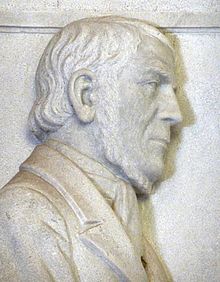Louis Tregardt | |
|---|---|
 Relief of Tregardt in the Voortrekker Monument, Pretoria | |
| Born | Louis Johannes Tregard[1] 10 August 1783 |
| Died | 25 October 1838 (aged 55) |
| Resting place | Maputo 25°58′06″S 32°34′15.5″E / 25.96833°S 32.570972°E |
| Occupation(s) | Field cornet, farmer |
| Spouse | Martha Elisabeth Susanna Bouwer (1795/96–1838) |
| Children | Four reached maturity: Carolus Johannes (1811-1901) |
| Parent(s) | Carolus (Carel)[3] Johannes Tregard, Anna Elisabeth Nel[2] |
Louis Johannes Tregardt[1][4] (from Swedish: trädgård, garden), commonly spelled Trichardt[5][6] (10 August 1783 – 25 October 1838) was a farmer from the Cape Colony's eastern frontier, who became an early voortrekker leader. Shunning colonial authority, he emigrated in 1834 to live among the Xhosa across the native reserve frontier, before he crossed the Orange River into northern territory. His northward trek, along with fellow trekker Johannes (Hans) van Rensburg,[7] was commenced in early[7] 1836. He led his small party of emigrants, composed of seven Boer farmers, with their wives and thirty-four children & native servants,[7] into the uncharted interior of South Africa, and settled for a year at the base of the Zoutpansberg.
At this most northerly point of their trek, unhealthy conditions began to take a toll on man and animal. Seemingly abandoned by a follow-up trek, and distant from supplies and buyers for their ivory, Tregardt abandoned the settlement, and led the party southeastwards to the Portuguese outpost at Delagoa bay that would later become Maputo (the capital city of Mozambique). The oceanward route proved arduous and included the challenge of traversing a section of the northern Drakensberg. Though reaching the fort at Delagoa bay, a number of their party contracted malaria en route. Tregardt's wife perished at the fort in May 1838, followed by Tregardt six months afterward.
- ^ a b Ransford, Oliver. "3: The Voorste Mense". The Great Trek.
- ^ a b Oberholster, Dr L. E., Die Groot Trek, Louis Tregardt, Biografiese besonderhede, archived from the original on 5 October 2011, retrieved 31 January 2011
- ^ Cite error: The named reference
Krugerwas invoked but never defined (see the help page). - ^ Raidt, E.H. (1980). Afrikaans en sy Europese Verlede (2nd ed.). Goodwood, Cape Town: Nasou Beperk. p. 135. ISBN 0-625-01442-1.
Footnote (translated): Various opinions exist concerning the spelling of the surname which arrived with Louis' grandfather from Sweden. This forebear and his son almost always wrote it as "Tregard". Louis initially wrote it as "Tregardt", and later mostly as "Trigardt". Only by 1881 did the spelling "Trichardt" gain priority with the family, as they deemed themselves to be of French ancestry. Today most authoritative works like the South African Biographical Dictionary maintain "Tregardt" as historically the most correct. - ^ Lucky (7 August 2013). "Louis Trichardt, Voortrekker leader, is born near Oudtshoorn 225 years ago". SA History Online.
- ^ Pretoria (South Africa). The Board of Control of the Voortrekker Monument (1955). The Voortrekker Monument, Pretoria: Official Guide. The Board.
- ^ a b c Ransford, Oliver (1972). The Great Trek. Great Britain: John Murray. pp. 33–35.